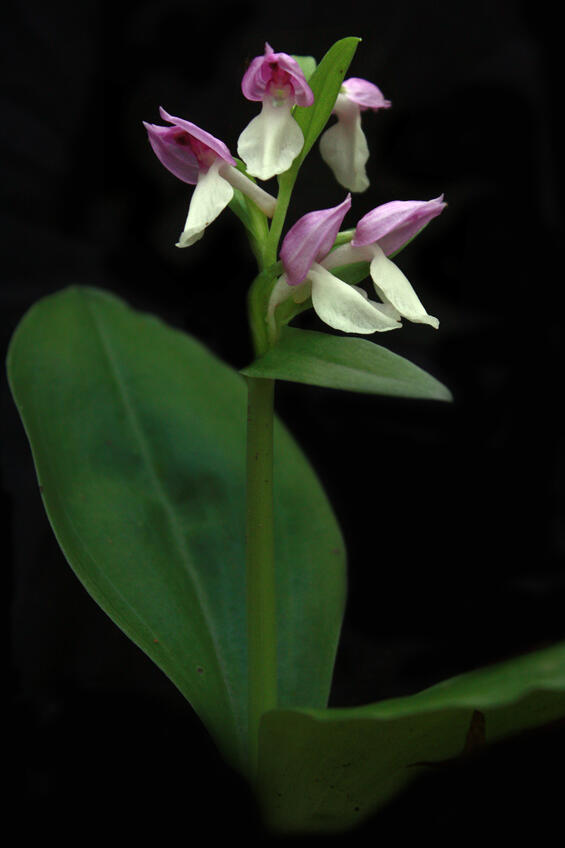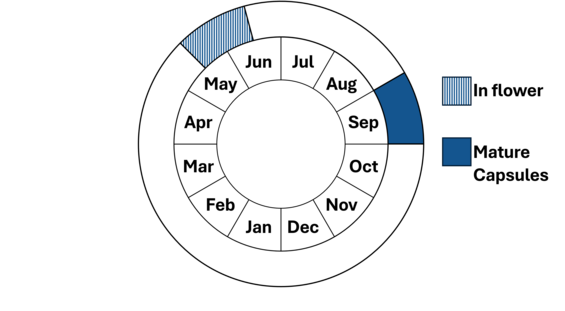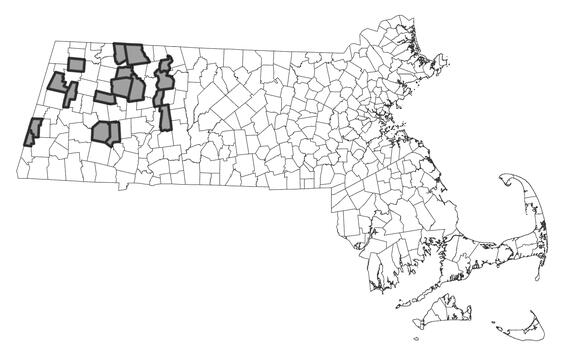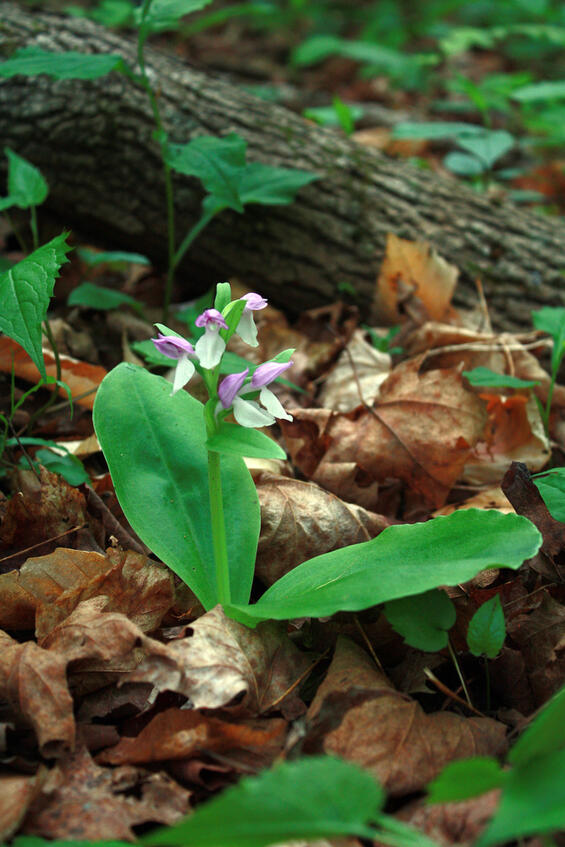- Scientific name: Galearis spectabilis (L.) Raf.
- Species of Greatest Conservation Need (MA State Wildlife Action Plan)
- Threatened (MA Endangered Species Act)
Description

Image Credit: Chris Buelow
Showy orchis (Galearis spectabilis) is a woodland, herbaceous, perennial species in the orchid family (Orchidaceae). Mature plants have two basal leaves opposite each other and a single raceme of pink and white flowers that arises between the leaves. The flowering stalk is typically 8-25 cm tall (6 in). The leaves are somewhat succulent, elliptical to ovate, 8-20 cm (3.2-7.9 in) long by 2-9 cm (0.8-3.5 in) wide. The raceme has 2 to 10 flowers, each with a leaf-like bract (2-6.5 cm [0.8-2.6 in]) below it. The petal-like sepals are purple and, with the upper purple petals form an arching hood. The labellum (lower petal) is white and hangs downward. A white club-shaped spur protrudes behind the flower. Like all orchids, these have a tuber with a couple of roots (2 to 8), that grow laterally.
Life cycle and behavior

Showy orchis is a perennial herbaceous species. It is one of the earliest orchids to flower, typically blooming in mid-May to mid-June. It is visited by bumblebee queens, including Bombus fervidus, Bombus griseocollis, Bombus impatiens, Bombus pensylvanicus and Bombus vagans early in spring, but the species rarely form seed capsules. When the flower is pollinated, the plant forms upright capsules which will open with slits in the fall. The orchid seed is tiny and is blown out of the capsule by strong winds and can travel long distances on the wind. Orchid seeds consist mostly of air with only a few cells for an embryo and are thought to be able to travel further distances than any other wind-dispersed flowering plant (Smith 2012). Many seeds will just fall near the parent plant. The orchid seed must land in an appropriate habitat and be infected by an appropriate mycorrhizal fungus before it will germinate. It is not known how long it will take for a seedling to produce a leaf above ground, it may only be one year, or it could be several. When it is ready it will produce a single leaf above ground. The first four to six years the plant will gain strength. It will then produce two opposite basal leaves and put up a flowering stalk. Once the plant starts to flower, it will probably live only a couple more years.
Population status
Showy orchis is listed under the Massachusetts Endangered Species Act as threatened. All listed species are protected from killing, collecting, possessing, or sale and from activities that would destroy habitat and thus directly or indirectly cause mortality or disrupt critical behaviors. There are currently 21 occurrences in the state verified since 1999 found in Berkshire, Franklin, Hampden, and Hampshire Counties. Twelve historical occurrences which have specific locational information are located in western Massachusetts in Berkshire, Franklin, and Hampshire Counties. The size of the populations varies from 4 or less (typically) to populations of over 100 genets.
Distribution and abundance
The documented range of showy orchis extends from New Brunswick province south to Georgia, west to Oklahoma and Nebraska and north to Ontario (NatureServe 2025). It is considered secure in the center of its range, but the states along the range margins include many that consider the species rare. In New England, the species is considered imperiled in Massachusetts and New Hampshire, critically imperiled in Maine, vulnerable in Vermont and Connecticut, and extirpated from Rhode Island.

Distribution in Massachusetts. 1999-2024. Based on records in the Natural Heritage Database.
Habitat

Image Credit: Chris Buelow
Showy orchis occurs in rich, mesic calcareous forests. Associated species include sugar maple (Acer saccharum), white ash (Fraxinus americana), blue cohosh (Caulophyllum thalictroides), rattlesnake-fern (Botrychium virginianum), maidenhair fern (Adiantum pedatum), long-spurred violet (Viola rostrata), wild leek (Allium tricoccum), trout lily (Erythronium americanum), toothworts (Cardamine spp.), squirrel corn (Dicentra canadensis), early meadow rue (Thalictrum dioicum), and wild ginger (Asarum canadense), among other plants common in rich, mesic forests.
Healthy habitats are vital for supporting native wildlife and plants. Explore habitats and learn about conservation and restoration in Massachusetts.
Threats
The primary threats to showy orchis are direct destruction of habitat by all forms of development; destruction of individual plants by collection, off-road vehicles, or trampling; and displacement by invasive plant species. Rich, mesic forests, the preferred habitat of this species, are particularly susceptible to invasion by exotic plant species. Invasive non-native species could shade out these low growing plants. Although many listed rare plants thrive with disturbance, showy orchis prefers minimal disturbance. While many orchids do well with occasional fire in their habitat, it is not known if showy orchis would respond well to fire. In addition, any disruption to forest mycorrhizae which this species relies on, would damage showy orchis populations. It is also browsed by deer and other mammals. Finally, showy orchis rarely produces seed capsules, it is not known why successful pollination of the flowers is extremely low. The forest canopy could also become too dense and shade plants and prevent them from growing.
Conservation
Showy orchis was listed as threatened under the Massachusetts Endangered Species Act only in 2024. Although this species has been on the plant watch list for several years, not all populations that have been documented by herbarium specimens have been surveyed for. A top priority will be to survey for older populations, both during flowering and post flowering to look for seed capsules. The best time to survey for this species is when it is in bloom during May and June.
Management needs should be determined site by site but is likely to include trimming low growing shrubs shading populations, and careful invasive species control. For some populations, cutting of a mature tree or two may be required to allow more light to the forest floor. Any trails that are close to populations or bisect them should be rerouted away from the plants. All active management of rare plant populations (including invasive species removal) is subject to review under the Massachusetts Endangered Species Act and should be planned in close consultation with MassWildlife’s Natural Heritage and Endangered Species Program.
There is much that is not known about showy orchis and its life history. Although it is known that the species requires mycorrhizal fungi to germinate and sustain plants during their life, the specific mycorrhizae species used by showy orchis throughout their life is not known. Research is needed to determine how many years it would take for orchid seedlings to produce leaves after germination. Also, how many years will a mature plant produce flowers? Why are there so few capsules produced by showy orchis, is there a problem with pollination, is it already inbred? Is it self-incompatible for pollination? Is it fire tolerant, and would it benefit from an occasional low intensity fire in its habitat?
References
Gleason, Henry A., and Arthur Cronquist. Manual of Vascular Plants of Northeastern United States and Adjacent Canada, Second Edition. Bronx, NY: The New York Botanical Garden, 1991.
Haines, A. 2011. Flora Novae Angliae – a Manual for the Identification of Native and Naturalized Higher Vascular Plants of New England. New England Wildflower Society, Yale Univ. Press, New Haven, CT.
Native Plant Trust. 2014. NORM Phenology Information.
NatureServe. 2025. NatureServe Network Biodiversity Location Data accessed through NatureServe Explorer [web application]. NatureServe, Arlington, Virginia. Available https://explorer.natureserve.org/. Accessed: 3/21/2025.
POWO (2025). "Plants of the World Online. Facilitated by the Royal Botanic Gardens, Kew. Published on the Internet; https://powo.science.kew.org/ Accessed: 3/21/2025."
Smith, Welby R. 2012. Native Orchids of Minnesota. University of Minnesota Press, Minneapolis MN.
Contact
| Date published: | May 7, 2025 |
|---|